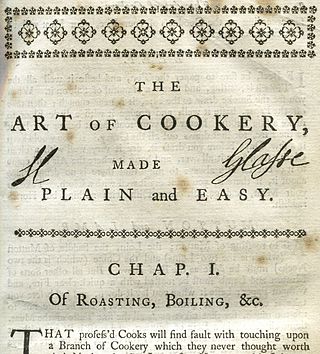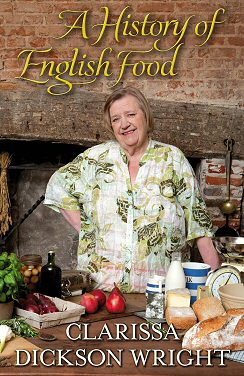
English cuisine encompasses the cooking styles, traditions and recipes associated with England. It has distinctive attributes of its own, but is also very similar to wider British cuisine, partly historically and partly due to the import of ingredients and ideas from the Americas, China, and India during the time of the British Empire and as a result of post-war immigration.

Meringue is a type of dessert or candy, of French origin, traditionally made from whipped egg whites and sugar, and occasionally an acidic ingredient such as lemon, vinegar, or cream of tartar. A binding agent such as salt, flour or gelatin may also be added to the eggs. The key to the formation of a good meringue is the formation of stiff peaks by denaturing the protein ovalbumin via mechanical shear.

Isabella Mary Beeton, known as Mrs Beeton, was an English journalist, editor and writer. Her name is particularly associated with her first book, the 1861 work Mrs Beeton's Book of Household Management. She was born in London and, after schooling in Islington, north London, and Heidelberg, Germany, she married Samuel Orchart Beeton, an ambitious publisher and magazine editor.

Shepherd's pie, cottage pie, or in its French version hachis Parmentier, is a savoury dish of cooked minced meat topped with mashed potato and baked, formerly also called Sanders or Saunders. The meat used may be either previously cooked or freshly minced. The usual meats are beef or lamb. The two English terms have been used interchangeably since they came into use in the late 18th and early 19th centuries, although some writers insist that a shepherd's pie should contain lamb or mutton, and a cottage pie, beef.

A cookbook or cookery book is a kitchen reference containing recipes.

Mulligatawny is a soup which originated from South Indian cuisine. The name originates from the Tamil words miḷagu, and taṇṇi ; literally, "pepper-water". It is related to the dish rasam.

Elizabeth David was a British cookery writer. In the mid-20th century she strongly influenced the revitalisation of home cookery in her native country and beyond with articles and books about European cuisines and traditional British dishes.

Hannah Glasse was an English cookery writer of the 18th century. Her first cookery book, The Art of Cookery Made Plain and Easy, published in 1747, became the best-selling recipe book that century. It was reprinted within its first year of publication, appeared in 20 editions in the 18th century, and continued to be published until well into the 19th century. She later wrote The Servants' Directory (1760) and The Compleat Confectioner, which was probably published in 1760; neither book was as commercially successful as her first.
Susan Hilary Spurling CBE FRSL is a British writer, known for her work as a journalist and biographer.
Fettiplace is an English family name, allegedly of Norman descent, originating with a landed gentry family chiefly of Berkshire and Oxfordshire, from which came a baronetical line, extinct.

John Fettiplace of Besils-Leigh in Berkshire, was a member of the landed gentry and of the prominent Fettiplace family who served as a Member of Parliament for Berkshire in 1558 and twice served as Sheriff of Berkshire, in 1568 and 1577.
Elizabeth David, the British cookery writer, published eight books in the 34 years between 1950 and 1984; the last was issued eight years before her death. After David's death, her literary executor, Jill Norman, supervised the publication of eight more books, drawing on David's unpublished manuscripts and research and on her published writings for books and magazines.

Modern Cookery for Private Families is an English cookery book by Eliza Acton. It was first published by Longmans in 1845, and was a best-seller, running through 13 editions by 1853, though its sales were later overtaken by Mrs Beeton. On the strength of the book, Delia Smith called Acton "the best writer of recipes in the English language", while Elizabeth David wondered why "this peerless writer" had been eclipsed by such inferior and inexperienced imitators.

Food in England is a 1954 book by the social historian Dorothy Hartley. It is both a cookery book and a history of English cuisine. It was acclaimed on publication; the contemporary critic Harold Nicolson described the book as a classic. It has remained in print ever since.

A Book of Mediterranean Food was an influential cookery book written by Elizabeth David in 1950, her first, and published by John Lehmann. After years of rationing and wartime austerity, the book brought light and colour back to English cooking, with simple fresh ingredients, from David's experience of Mediterranean cooking while living in France, Italy and Greece. The book was illustrated by John Minton, and the chapters were introduced with quotations from famous writers.

A History of English Food is a history of English cuisine from the Middle Ages to the end of the twentieth century written by the celebrity cook Clarissa Dickson Wright. Each era is treated in turn with a chapter. The text combines history, recipes, and anecdotes, and is illustrated with 32 pages of colour plates.

Thomas Dawson was an English author of cookery and housekeeping books.

The Good Huswifes Jewell is an English cookery book by the cookery and housekeeping writer Thomas Dawson, first published in 1585. It includes recipes for medicines as well as food. To the spices found in Medieval English cooking, the book adds herbs, especially parsley and thyme. Sugar is used in many of the dishes, along with ingredients that are uncommon in modern cooking like violets and rosewater.
Elizabeth Freke (1641–1714) was an English memoirist and poet, known for her diaries and remembrances, but also for a collection of recipes covering medicine and cooking. Her poetry includes a dramatic dialogue between Eve and the Serpent of Eden.
Elinor Fettiplace was an English cookery book writer. Probably born in Pauntley, Gloucestershire into an upper class land-owning farming family, she married into the well-connected Fettiplace family and moved to a manor house in the Vale of White Horse, in what was then Berkshire.














